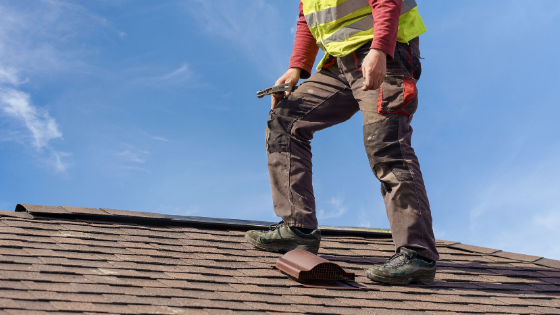Spring Cleaning Checklist for your Roof

Now that spring is here, it’s time to do your once-a-year cleaning around your home and outdoors as well to prepare your home for the new season.
Doing a little maintenance and fixing things here and there can help prevent bigger issues occurring around your house so that’s why it’s important to keep a maintenance and cleaning checklist for the spring season and not forget about anything.
While you take care of your house inside and you make sure everything is clean and spotless, it’s important not to forget about the outside, too.
The roof is usually something many people look over when they really shouldn’t do that. Keeping your roof clean and inspecting it regularly will give more safety to your house and your family and it will last longer before having to replace it, ultimately, saving you money.
In this article, we’ll provide you some spring cleaning tips for your roof!
- Clean out gutters- Clogged gutters might be the main causes of leaks in your roof. They can get clogged easily if you have trees around your house, they shed leaves during fall and winter. Leaves along with other sludge can build up in the gutters, so now that spring is here, it’s the perfect time to clean them to prevent leaks and other damages in the roof.
- Cut back the trees-If you have trees around your house, it would be wise to cut them back, and maintain them regularly to prevent branches damaging your roof or other parts of the house. This will also eliminate the problem of leaves clogging your gutters.
- Moss and mold- Spring is a good time to think about washing your roof and actually do it. You want to look out for moss, mold, and dirt and give your roof a good wash using a general cleaner solution. With time, moss, mold, and dirt can eat away your roof’s materials ultimately damaging it.
- Damaged flashing- Your old flushing may not be able to handle rainy weather and heavy rain showers. You might want to check your flushing and if you find any worn areas or gaps, there is a good chance that water will go in.
- Inspect the attic- Going up to the attic gives you a chance to look at the roof from a different angle. For example, if you see any light coming in, there might be a chance of a hole in the roof. You should also check for any mold or mildew which can also have a bad smell. Also, check for water damage and stains.
- Check for missing shingles- Curled shingles may be the result of a bad installation or poor ventilation. Blistering shingles might be the sign of an excessive amount of moisture being trapped in a shingle. If you don’t take care of the problem, the shingle will burst and cause more serious damages. Also, look for any signs and stains on the streaking. These two indicate that there is a leak, or there is damage in your roof’s ventilation.
- General wear and tear- You might want to look for general wear and tear that occurs over time. They are easy to spot because they usually appear in larger areas.
- Hire an inspector- Sometimes it is hard to find possible damages and leaks on your roof by yourself. The best and safest thing to do in this case is calling a professional with experience to take a look at your roof. Don’t wait until it’s too late. The damage won’t go away by itself and you might end up paying more.
These are the most important things to check for on your roof during your spring cleaning. Maintaining your roof regularly will give your home safety and it will save you from spending a lot of money.
How much does a roof inspection cost?
Roof inspectors usually charge a fixed price for their service. Although, some roof inspectors take into consideration some of the following aspects:
- Size of the house
- The slope of the roof
- The shape of the roof
- Age of the house/roof
The average cost of a professional roof inspection is usually around $250. Although, this can vary, depending on the size of your home. If your home is larger than 3000 square feet, and it has multiple floors, you might have to pay more.
Types of Roof Inspections
Roof inspections vary depending on the material of your roofing. Different types of roofs will need different inspections. For example, in wooden shingles, the inspector needs to look for rot and rust. Fiberglass shingles can develop cracks. The weather and climate are also important aspects to take into consideration while inspecting a roof.
How often should I get a roof inspection?
According to the general guidelines of roof inspectors, you should get a roof inspection every three years in case you have asphalt shingle or wooden shingle roof. However, if you have a tile roof, you can have 5 years between inspections.
But if you notice that something in your roof is damaged or changed color, you should probably call a professional and get your roof inspected.
In the first part of this article we talked about the importance of including your roof in your spring cleaning routine, and listed a couple of tips on what to look out for when you inspect your roof like cleaning the gutter, cutting back the trees around the house, moss, and mold, damaged flashing, inspecting the attic and looking for missing shingles. These should be checked regularly to maintain your roof and keep your house clean and safe.
Next, we talked about the costs of a roof inspection, which can be a fixed price or a price depending mostly on your house’s size and age.
Last, we mentioned we discussed how often you should get a roof inspection, which depends on the material your roof has. Regular roof inspections are very important, and shouldn’t be neglected, because the roof provides you with defense against extreme weather conditions. And at the end of the day, the safety of our loved ones is our number one priority.

In Awe Roofing Limited is an Award-Winning, family owned and operated Vancouver Roofing Contractor with over 17 years of roofing experience. We serve the entire Lower Mainland area, from Whistler to Chilliwack, employing a team of professional staff members. Our team has won numerous awards including Best of Homestars for the last five years, and Three Best Rated six years in a row. Learn more






















